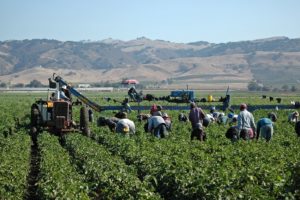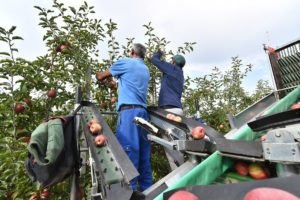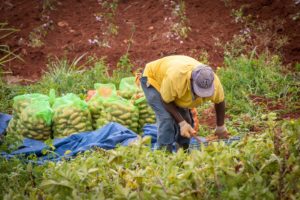
Labor Availability
Why does Labor Availability matter?
Ag Workers? What Ag Workers?
Frank Gasperini
Published in Fruit and Vegetable Growers News
As I write this month’s column the Congress is still debating whether they should defund the Department of Homeland Security (DHS) while telling, or rather warning, agriculture groups that we should support mandatory E-Verify for every employee along with enhanced border security now, with a non-specific promise that they will get to our workforce issues later. Many of us of a certain generation cannot help but recall a particular cartoon character from our youth who always said “I will gladly pay you tomorrow for a hamburger today.” You always wondered if the payer could really count on getting paid tomorrow. We still wonder about promises of help later, in return for support or non-objection today. Mandatory E-Verify that is not concurrent with or led by immigration reform that lets our current workers legally continue working for us while providing a workable, economically viable, scalable, and sustainable future flow of workers for ALL agricultural employers; including those with year-around needs is a farm and job killer. A farm and job killer, period. Since the word sustainable seems to mean whatever the writer calls it when applied to agriculture, I mean a program that can work as intended/needed for years while being ethical and moral from both business and personal grounds. Specifically that growers and workers are both better off at the end of each season than had they not worked together for years to come.
This current fight comes at the same time we face a faster and faster decline in domestic workers both local and migrant, and an increasingly hostile regulatory process for acquisition and compliance in using the legal guest worker programs, H-2A for agriculture and H-2B for non-agriculture including processing. We have discussed the growing need for willing, able, and reliable workers in the past. We have also discussed the need for constant growth in efficiencies to allow available workers to be as productive as possible and the constant claims by those who do not understand the nature of fruit and vegetable production to say we could simply mechanize as the corn and soybean growers do, or just pay more to attract the workers we need. We will not waste ink re-plowing that ground however two relatively new studies back up our concern. One from a NY State survey of apple growers suggests that despite increasing productivity by existing workers the need for workers will continue to grow in coming years. This survey, is from Tom Maloney, Sr. Extension Specialist Dyson School of Applied Economics Management of Cornell University. The second is a January 12, 2015 American Journal of Agricultural Economics article discussing and documenting steep decline of the pool of domestic migrant workers.
The continuing concern that we will not see significant legislative improvements in the 114th Congress coupled with continuing regulatory agency hobbling of the only legal temporary worker programs had caused us to focus on practical steps we might take to push the current programs to work more as they were intended. This is the conclusion that my association, NCAE, has arrived at. While we continue to work toward fuller legislative corrections, we plan to focus on using all the help we can get from agriculture friendly agencies, Congressional rep pressures, grassroots pressures, and even litigation to encourage the regulations we are now governed by, that we must all live with until better legislation is achieved, to be administered in ways that at least do no harm to US domestic agriculture. Until we get to real possibilities of Congressional action, we intend to use our limited resources to push, pull, or beg the current regulators and administrators to make the existing programs better serve agriculture.
We do not advocate that any enforcement or regulatory agencies break-faith with their legislative or regulatory mandates, but that they take time to understand the differences in agricultural businesses and those businesses with highly predictable ebbs and flows that are not so directly impacted by uncontrollable variables, and/or are part of large corporations for whom a new and last-minute reporting or procedural change is accomplished by a back-room employee or team and implemented nationwide across multiple locations.
Over the coming months you will read about our ongoing effort to engage with upper management at various agencies to educate them in the realities of agricultural business management, the economy, homeland security, and moral values of continuing to produce the bulk of our food supply domestically, and when necessary targeted invitations to various agency personnel to visit with Congressional representatives who understand the issues. None of these activities are short-term fixes, but in lieu of major legislative reforms which appear less likely in the atmosphere of this Congress, they are the pathways open to us for whatever improvements we can harvest in the orchards, fields, and barns of Washington, DC.
Data and Statistics on Labor Availability
56%
Percent of farmers reported they have used a labor-saving technology, and of those who began using mechanization, 56 percent did so due to employee shortages.
56%
In the 2019 survey, 56 percent of participating farmers reported they had been unable to hire all the employees they needed for production of their main crop at some point during the past five years.
86%
Percent of farmers responding to the survey said they had raised wages in efforts to hire enough people.
Labor Availability
Primary Issues:
In 2010 the National Council of Agricultural Employers completed a substantial survey of H-2A Employers now known as the ALRP. The Survey found that the H-2A Program did not serve growers needs in seeking a reliable, legal workforce – Growers faced economic loss from H-2A program rules and administration, unpredictable start times, a historic number of administrative appeals, and increased regulatory burdens.
Currently, despite lack of current extensive data, NCAE still operates on the principles outlined in this survey and continues to work with both the Ag Employer Community and the Federal Agencies that administer the H-2A Visa to help lessen the regulatory burden and increase the effectiveness of this program until other alternatives can be found through the legislative process.
Another study shows that “migrancy” is down. This study from Ball State University discusses trends including a continuing decline in migrancy. The summary also says the percentage of female migrant workers has increased and also discusses more issues that deserve further study. There may be a contradiction in that while documented workers still migrate, undocumented workers appear less migratory due to risk of being apprehended, but then one of the conclusions is that status normalization might cause even less migrancy and thus make the labor situation worse.
See the study here: 2014 Ball State Study – Why Do Fewer Agricultural Workers Migrate Now.
Latest News on Labor Availability
Get in Touch
While the NCAE focuses on advocating for Agricultural Employers at the national level, we also aim to serve as a reliable resource for our members. If you have a question or concern, send us a message.





